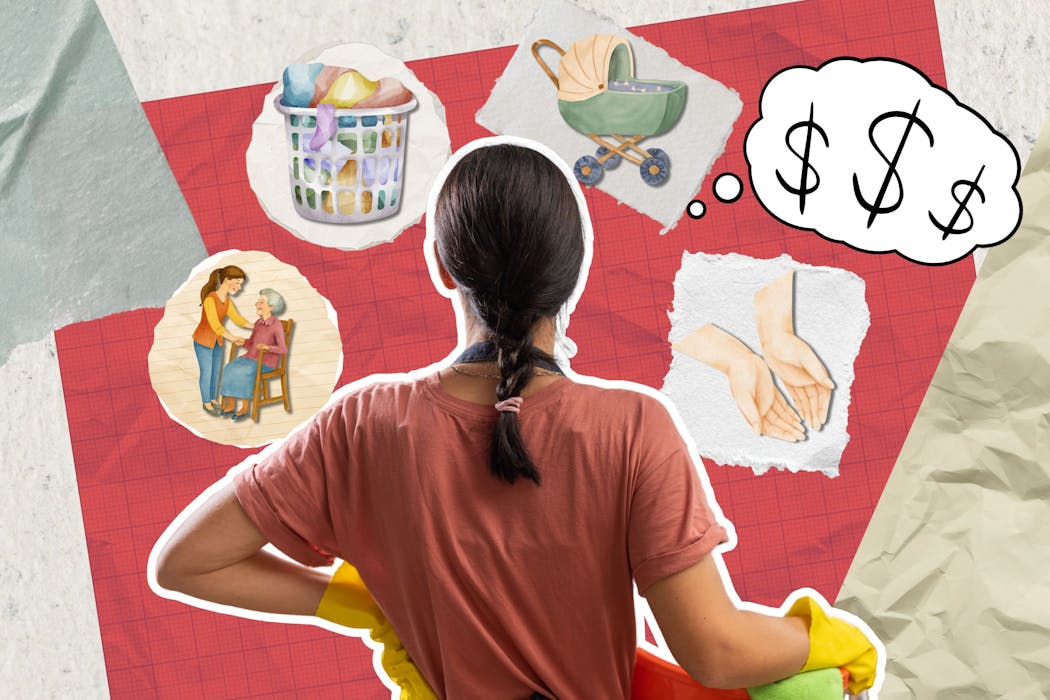Unpaid ‘women’s work’ is worth $427 billion, new research shows. See how much your unpaid labour is worth
- Written by Leonora Risse, Associate Professor in Economics, University of Canberra

All those thousands of hours that Australians put towards unpaid household work and care – cooking, cleaning and caring for family members – are an essential thread that keeps our economy stitched together.
But they’re not recognised in official economic statistics.
My new research puts a dollar value on what all this unpaid labour is worth to the economy: about A$688 billion. That’s equivalent to around one-third of gross domestic product – and is mostly contributed by women.
What happens when we count it in?
The System of National Accounts, which guides how countries worldwide define “production” and measure the size of their economy, is limited to activities that have a price tag or market wage.
Unpaid work and care falls outside this official definition.
In my new academic paper, published in the Economic Record, I calculate a dollar value of this unpaid productive activity by adding up how much it would cost if we were to pay someone an hourly wage do this work as their paid job.
For example, we can value each unpaid hour looking after children as the equivalent of a childcare worker’s average hourly wage.
Each hour spent on housework can be calculated by using a domestic cleaner’s wage as a proxy. And time spent on meal preparation can be proxied using a kitchen hand’s typical wage.
Women contribute the bulk (61.5%) of total time spent on unpaid work and care, based on data collected by the Australian Bureau of Statistics’ Time Use Survey.
The average time and type of unpaid work that women do, which tallies to 3 hours and 56 minutes per day, equates to A$771 worth of labour per week.
Men’s typical unpaid work and care, which averages 2 hours and 28 minutes per day, adds up to $493 weekly.
Tallying up for the population, women’s unpaid labour is worth the equivalent of $427.3 billion per year. Men’s unpaid work amounts to $261 billion. Yet none of this vital work is counted in our national accounts.
Women’s real contribution to the economy
Let’s imagine we add another column to our national accounts ledger which now counts this invisible labour and adds it to our measurement of paid labour.
We see that women’s share of total labour effort in the economy expands to 47.2%. This compares with just 36.8% when we only count paid work.
One problem with this “replacement wage” methodology is many of these proxy occupations used to value unpaid work and care are female-concentrated – and systematically undervalued on the basis of gender.
We can fix this by estimating a wage equation, using HILDA Survey data, to measure the extent by which an occupation is systematically paid less (or more) on the basis of its gender composition. While we’re at it, we can also estimate the wage premium enjoyed by men irrespective of their industry and occupation.
When we adjust for these sources of gender-based undervaluation, women’s share of total labour climbs to 50.5%.
In other words, women and men are contributing roughly equal labour effort to our economy. But it’s not reflected in the way we measure our economy, or in the gender gaps that persist in pay, wealth, assets and control over resources.
These findings have practical use in setting wages, dividing up household assets, and even measuring productivity.
The observed decline in measured productivity – occurring at the same time the care sector is rapidly swelling in size – could very well be due to an economic system that is failing to fully recognise the value of female-concentrated sectors.
This is about more than just numbers
The invisibility and under-recognition of “women’s work” – that is, the work that society assigns to women – is not just a matter of numbers.
It’s an erasure and diminishing of the value of women’s capabilities and contributions to our economy.
The gender biases embedded in conventional economic architecture are a marker, and driver, of women’s lower status, power and decision-making authority.
Feminist economics have long been pointing out the shortcomings of economic frameworks that centre on the productive activities traditionally assigned to men. As feminist academic Marilyn Waring bluntly observed:
The laws of economics and those that govern the UNSNA [United Nations Systems of National Accounts] are creations of the male mind and do not reflect or encompass the reality of the female world. The conceptual models are limited to the world that the economist knows or observes, and housework is most certainly not part of that world.
Counting unpaid work and care is now possible with the Australian Bureau of Statistics bringing back the Time Use Survey in 2020–21. The survey was previously last conducted in 2006.
This ongoing investment in Australia’s data infrastructure is crucial for applying a gender lens to our economic statistics and policy analysis, undoing gender biases, and shining a spotlight on uncounted “invisible” work.
Authors: Leonora Risse, Associate Professor in Economics, University of Canberra



















